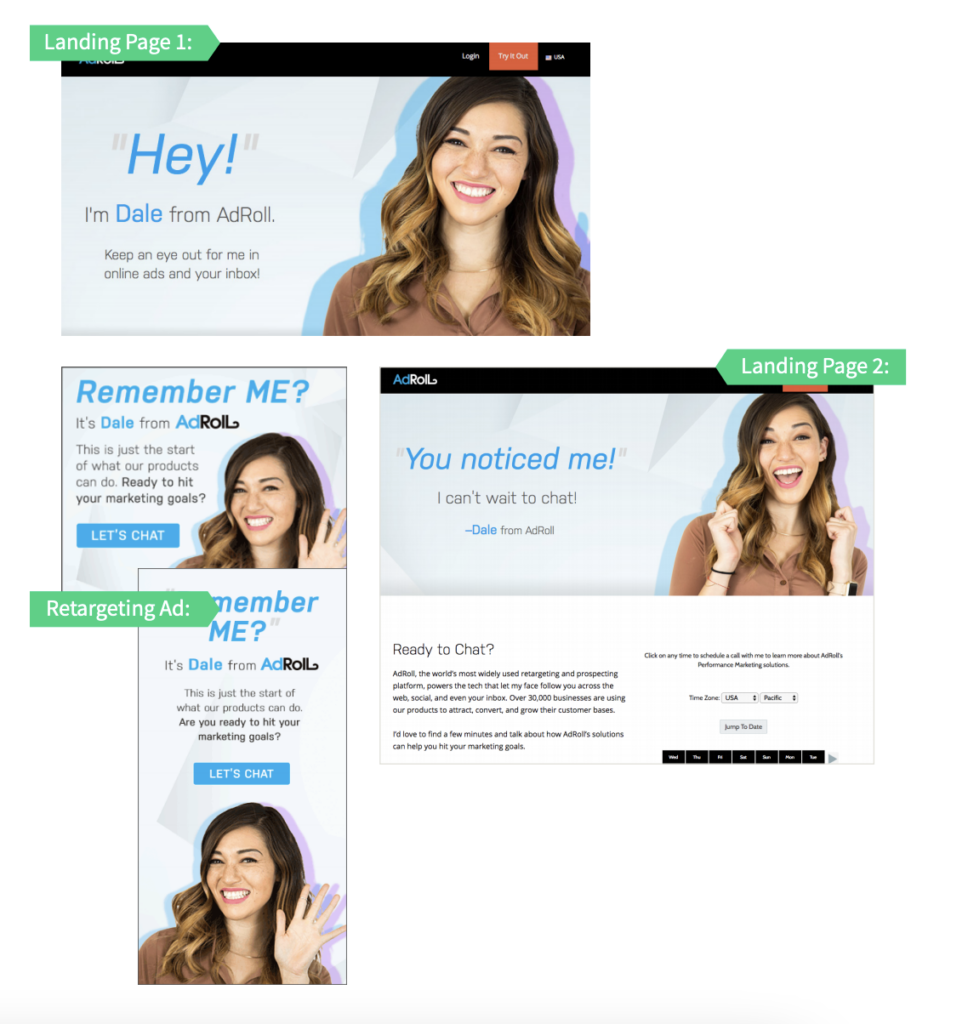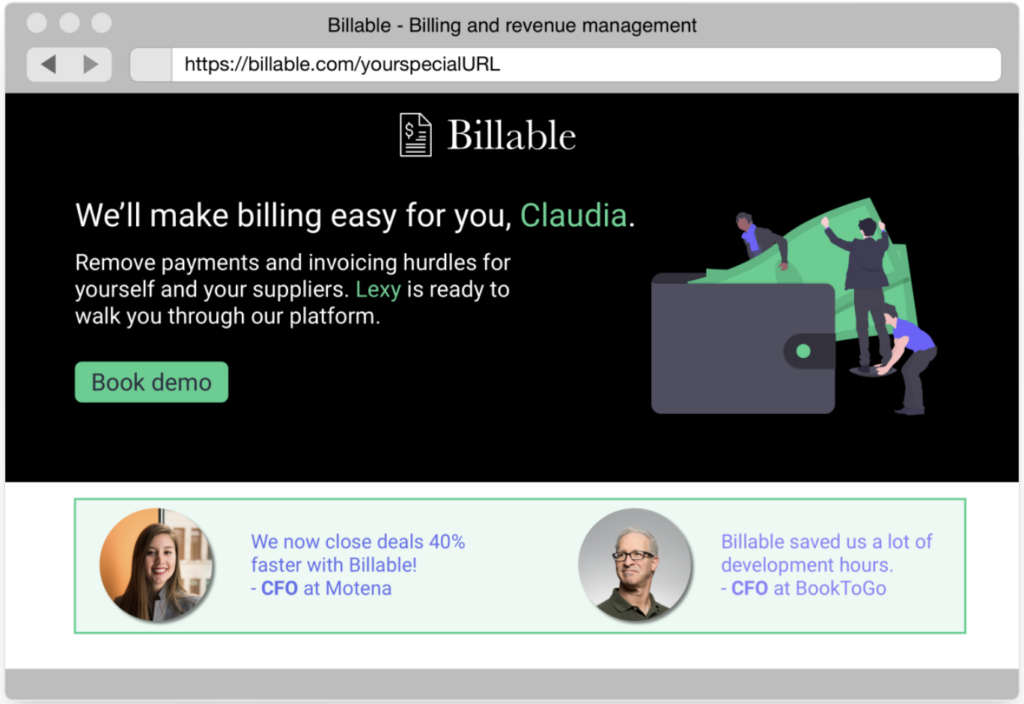With account-based marketing (ABM), companies can use ABM landing pages to create personalized campaigns that target their high-value prospects and accounts. Unlike traditional marketing approaches that cast a wide net, account-based marketing programs are precise, they require a deep understanding of target accounts and tailored messaging.
One of the key areas where messaging can be customized to your key accounts is on your website landing pages.
In a 2019 study conducted by Hanover Research for PROS, 69% of buyers said that personalized experiences helped them purchase a product. Even better, they were willing to pay more if a specially tailored price was quoted. Your landing page is exactly where this magic can happen.
What Makes ABM Landing Pages Different?
At its core, account based marketing is a strategic approach that coordinates personalized marketing and sales efforts to target specific accounts. This strategy treats individual accounts as markets in their own right, tailoring campaigns to resonate with the unique needs and characteristics of each.
ABM vs. traditional marketing landing pages differ in a few ways:
- They’re highly personalized, speaking directly to the challenges and pain points of the target account
- They're collaboratively created between marketing and sales teams, ensuring alignment in messaging and goals
- ABM landing pages also typically feature more detailed and specific content, aimed at engaging stakeholders within the target account at different stages of the buying journey. You can track this success by using ABM software.
How to Create ABM Landing Pages that Convert
Creating effective ABM landing pages requires a strategic approach aimed at engaging and converting target accounts. Here are some steps to consider:
1. Identify Target Accounts
Identifying target accounts and decision-makers is pivotal in ABM landing page creation. ABM focuses on personalized marketing for specific accounts, rather than a broad audience, necessitating precise targeting.
To pinpoint target accounts and decision-makers, perform thorough research on market segments, industries, and company profiles. Consider things like:
- company size
- Location
- Revenue
- Pain points
- Key decision-makers
Once you have a list of target accounts, tailor your ABM landing page to resonate with these targets, using personalized web content and language. Highlight how your offerings address their needs and add value. This focused approach enhances conversion rates and fosters stronger relationships with key accounts.
2. Craft Your Value Proposition
Crafting a compelling value proposition is vital for an ABM landing page. It's a statement articulating how your offerings solve customers' problems or fulfill their needs, persuading them that your business is their best solution.
To craft this proposition effectively, grasp the needs and pain points of your target accounts. Highlight what sets you apart from competitors and emphasize unique benefits. Ensure clarity, conciseness, and relevance to your audience's needs.
You may also want to address potential objections, such as pricing concerns, by emphasizing long-term value or cost savings. A well-crafted value proposition enhances communication of your business's value, boosting conversion chances on your ABM landing page.
3. Design Your Layout
Designing a visually appealing layout is crucial for an effective ABM landing page. It should be easy to navigate, with a clear information hierarchy guiding users to your desired call to action.
Consider these factors:
- Clean Design: Avoid clutter and excessive elements, using whitespace.
- Contrasting Colors: Use contrast to draw attention to important details.
- Quality Images: Include relevant, quality images to enhance visual appeal.
- Clear Headings: Use clear headings and subheadings for easy scanning.
By incorporating these elements into your layout, you can create an ABM landing page that not only captivates your audience visually but also aids them in navigating it effectively and results in a positive user experience.
I recommend you test a few design variations out for yourself and track their performance metrics. When you find one that works well, keep it as a template for future ABM campaigns.
4. Social Proof and Testimonials
Social proof, case studies, and customer testimonials are powerful tools for building credibility and trust on your ABM landing page. Social proof, the concept that people are influenced by the actions of others, can significantly impact purchasing decisions. When potential customers see others benefiting from your products or services, they're more likely to trust your business.
Customer testimonials, a form of social proof, are particularly effective in influencing potential customers. By showcasing satisfied customers' experiences, you demonstrate the value and effectiveness of your offerings.
To integrate social proof and testimonials effectively:
- Quotes from Satisfied Customers: Highlight key benefits and value through quotes from happy customers.
- Customer Reviews and Ratings: Display positive reviews and ratings to show others' positive experiences.
- Social Media Presence: Showcase your social media followers and engagement to bolster credibility.
By incorporating these strategies, your ABM landing page can instill trust and credibility, increasing the likelihood of conversion.
5. Tailor It With Dynamic Content
Personalizing the user experience through dynamic content is key to enhancing your ABM landing page's relevance. Dynamic content adapts to users' specific needs and interests, such as location, industry, or past interactions.
To implement dynamic content effectively, use:
- Personalization Tokens: Utilize placeholders replaced with personalized content, like the user's company name, to enhance engagement.
- Segmentation: Divide your audience into groups based on common characteristics or interests, allowing for tailored content creation.
- Dynamic Content Blocks: Show or hide content sections based on criteria like location or industry, ensuring relevance for each user.
By employing dynamic personalization of your ABM content, you can create a targeted experience. Consider taking the approach of one-to-one marketing—the most personalized and targeted form that ABM can take—to really boost engagement and conversion rates on your landing page.
6. Optimize For Mobile
Optimizing your ABM landing page for mobile devices is crucial for accessibility and effectiveness, given the rising prevalence of smartphone and tablet usage for web browsing.
To ensure mobile optimization, focus on:
- Responsive Design: Ensure your landing page adapts seamlessly to different screen sizes and orientations.
- Simplicity: Keep the design clean and uncluttered, considering the limited space on mobile screens.
- Large Buttons: Use sizable, easy-to-tap buttons for clear calls to action, facilitating user interaction.
- Readable Fonts: Employ large, legible fonts to enhance readability on smaller screens.
- Concise Forms: Shorten forms to accommodate users on the go, increasing conversion potential.
By implementing these practices, your ABM landing page becomes accessible and effective across all devices, catering to the diverse needs of your audience.
7. Personalize Your CTAs
In crafting an effective ABM landing page, personalized calls to action (CTAs) play a pivotal role. CTAs prompt users to take specific actions, like signing up for a newsletter or making a purchase.
To optimize your CTA, use:
- Action-Oriented Language: Utilize direct language that prompts action, such as "Sign up now" or "Learn more."
- Prominence: Ensure your CTA stands out and is easily accessible, capturing users' attention promptly.
- Personalization: Tailor your language to resonate with the needs and interests of your target accounts and decision-makers.
- Testing: Experiment with various CTAs to identify the most effective ones in driving conversions.
By employing targeted and personalized CTAs, you can effectively guide users toward desired actions, boosting conversion rates on your landing page.
8. Use A/B Testing
Testing and measuring your ABM landing page's effectiveness is crucial for optimizing its performance. Analyzing data allows you to pinpoint areas for improvement and enhance results.
Methods for testing and measuring include:
- A/B Testing: Compare two versions of your landing page to determine which performs better by splitting traffic between them.
- Heat Maps: Visualize user clicks on your page to identify high-traffic areas, optimizing them for conversions.
- Scroll Maps: Determine user scroll depth to identify areas of high and low engagement, adjusting page content accordingly.
- Form Analysis: Evaluate form submission data to understand user behavior, including completion rates and preferred fields.
By employing these testing methods, you can refine your ABM landing page for optimal performance and drive better results.
9. Integrate with your CRM and other platforms
Integrating your ABM landing page with your CRM and marketing automation software enhances marketing efficiency and provides deeper insights into target account behavior.
A CRM manages and analyzes customer interactions, aiding in outreach, tracking, and managing target account data centrally. Marketing automation platforms automate tasks like email marketing and lead scoring, improving campaign performance.
By integrating your ABM landing page with these systems, you streamline marketing campaign efforts, gain insights into target behavior, and optimize campaigns for improved results.
ABM Landing Pages Case Studies: Some Great Examples
Here are some of the best examples we've seen of ABM landing pages in action:
Rollworks
Rollworks, a B2B growth platform, aimed to expand its operations, recruit more SDRs, enhance deal progression, improve post-meeting account nurturing, and refine new client onboarding processes.
To address these objectives, they implemented a comprehensive account-based marketing (ABM) initiative where they ran an email campaign that directed prospects to personalized landing pages, initiating meaningful conversations. To bolster this phase, they deployed "air cover" advertisements to engage prospects and personalized retargeting ads to encourage those who had shown interest to proceed to the next stage of their ABM funnel.
This initiative yielded a remarkable threefold increase in appointment rates and a 15% uptick in closure rates.

Billable.com
Billable uses personalization, addressing a contact within a targeted account, Claudia, and mentioning her account manager, Lexy. They include quotes from satisfied customers, specifically CFOs like Claudia, adding a subtle yet thoughtful touch.
Consider taking this tactic from Billable and personalizing the headline with the recipient's name or customizing it based on their job role. For example, address a salesperson aiming to close more deals directly: "Welcome, Anton. Sales Managers like you thrive with our CRM, streamlining relationship management and accelerating deal closures with intuitive workflows."

Add ABM Landing Pages to Your Marketing Strategy
Creating high-converting ABM landing pages requires careful planning, personalized content, and continuous optimization. By following these best practices and drawing inspiration from successful examples, you can effectively engage and convert your target accounts.
For more insights into ABM strategies and tactics, explore our blog, connect with us on social media, and subscribe to The CMO newsletter!


